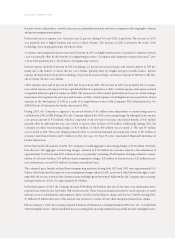American Express 2003 Annual Report Download - page 37
Download and view the complete annual report
Please find page 37 of the 2003 American Express annual report below. You can navigate through the pages in the report by either clicking on the pages listed below, or by using the keyword search tool below to find specific information within the annual report.
policyholder behavior experience to its assumptions. For annuity and universal life insurance products, the assumptions
made in projecting future results and calculating the DAC balance and DAC amortization expense are management’s best
estimates. Management is required to update these assumptions whenever it appears that, based on actual experience or
other evidence, earlier estimates should be revised. When assumptions are changed, the percentage of estimated gross prof-
its or portion of interest margins used to amortize DAC might also change. A change in the required amortization percent-
age is applied retrospectively; an increase in amortization percentage will result in a decrease in DAC balance and increase
in DAC amortization expense while a decrease in amortization percentage will result in an increase in DAC balance and a
decrease in DAC amortization expense. The impact on results of operations of changing assumptions can be either positive
or negative in any particular period and is reflected in the period in which such changes are made.
For other life and health insurance products, the assumptions made in calculating the DAC balance and DAC amortization
expense are intended to provide for adverse deviations in experience and are revised only if management concludes expe-
rience will be so adverse that DAC is not recoverable.
For annuity and life and health insurance products, key assumptions underlying these long-term projections include inter-
est rates, equity market performance, mortality and morbidity rates and the rates at which policyholders are expected to
surrender their contracts, make withdrawals from their contracts and make additional deposits to their contracts. Assump-
tions about interest rates drive projected interest margins, while assumptions about equity market performance drive pro-
jected customer asset value growth rates and assumptions about surrenders, withdrawals and deposits comprise projected
persistency rates. Management must also make assumptions to project maintenance expenses associated with servicing its
annuity and insurance business during the DAC amortization period.
The customer asset value growth rate is the rate at which contract values are assumed to appreciate in the future. The rate
is net of asset fees and anticipates a blend of equity and fixed income investments. Management reviews and, where appro-
priate, adjusts its assumptions with respect to customer asset value growth rates on a quarterly basis. The Company uses a
mean reversion method as a guideline in setting near-term customer asset value growth rates based on a long-term view of
financial market performance. In periods when market performance results in actual contract value growth at a rate that is
different than that assumed, the Company will reassess the near-term rate in order to continue to project its best estimate
of long-term growth. Management is currently assuming a 7 percent long-term customer asset value growth rate. If the Com-
pany increased or decreased its assumption related to this growth rate by 100 basis points, the impact on the DAC balance
would be an increase or decrease of approximately $40 million.
Management monitors other principal DAC assumptions, such as persistency, mortality, morbidity, interest margin and
maintenance expense levels each quarter. Unless management identifies a material deviation over the course of the quar-
terly monitoring, management reviews and updates these DAC assumptions annually in the third quarter of each year.
The analysis of DAC balances and the corresponding amortization is a dynamic process that considers all relevant factors
and assumptions discussed above. Therefore, an assessment of sensitivity associated with changes in any single assumption
would not necessarily be an indicator of future results.
CONSOLIDATED LIQUIDITY AND CAPITAL RESOURCES
Capital Strategy
The Company generates equity capital primarily through net income to fund current needs and future business growth
and to maintain a targeted debt rating. Equity capital generated in excess of these needs is returned to shareholders
through dividends and the share repurchase program. The maintenance of a strong and stable equity capital base pro-
vides the Company with a strong and stable debt rating and uninterrupted access to diversified sources of deposit and
debt financing to fund growth in its assets, such as cardmember receivables. The Company maintains flexibility in its
equity capital planning and has developed a contingency funding plan to ensure that it has adequate sources of financ-
ing in difficult economic or market environments.
(p.35_axp_ financial review)
























